Community > Posts By > Seamonster
|
This weekend, I was driving down the road when something behind me caught my eye. I looked in my rear-view mirror and there were three college aged guys in the car behind me laughing and flailing their arms around erratically. At first, I just thought they were frat being silly, but then one of the guys opened his window, stuck his head out, and yelled, “**** atheists!”
I have to say that I never had such a reaction to my bumper sticker before. The funny thing is that there guys didn’t even seem all that religious. I am usually pretty good at spotting fundamentalist Christians and I really don’t think these guys were hard core believers. I could of course be wrong on that. I have driven through much more religious places before and much more religious people have seen my bumper sticker, but yet these three college kids felt the need to shout, “**** atheists!” That is really the thing about atheism. While it is true that atheists face all kinds of discrimination, threats of violence, and hate from various fundamentalist Christians, we also sometimes get similar reactions from people who aren’t fundamentalists or even some Christians who don’t even really think about their religion very much at all. This is why I think it is so vitally important for atheists to be vocal about their lack of belief. The general public needs to know that we are out here and they need to understand that we aren’t going away. In fact, as time and modernity ticks by, more and more people are starting to think critically about religion. More and more people are starting to doubt the stories that have been indoctrinated into them since before they could speak. As a result of time and modernity, Christian apologists have had to re-interpret their timeless holy books to fit better with science and secular society. The more I think about it, the happier I am at the reaction that my bumper sticker causes with those guys. I know that later that night at least one of them (and probably all three of them) will think about their behavior. They might even joke about it with each other at first and laugh about evil atheists. But all that is part of the process. I think is it common for people to resort of base insults when they feel insecure with themselves on particular issues. This is also why many homophobic people are later exposed as being closeted gays or as the Reverend Ted Haggard put it, “heterosexual but with homosexual attachments.” I find that most Christians who lash out with base insults and childish behavior toward non-god-believers are in reality struggling with their own faith behind closed doors. They are afraid of their own thoughts and desperate to prove to others and even to themselves that they still believe. They still usually want to believe, but the fortunate fact is that they are slowly realizing that their belief just doesn’t make sense. They are atheists with Christian attachments. |
|
|
|
|
|
IF man evolved or even diverged from a chimp...... then why is the chimp still around ? 
  
You're not serious, are you? Just google "Are chimps evolving?" and read the articles! Are chimps evolving? Perhaps so....and if so....it would ONLY be WITHIN their OWN SPECIES!! BUT.... chimps CANNOT evolve into a WHOLE OTHER SPECIES !!!! NEVER HAVE and NEVER WILL!!! Cause God's WORD does NOT Lie.   
we share 89% the same DNA as the ape. I'm sure god did that just to mess with us so people will think we evolved and then more people will go to his hell. |
|
|
|
|
|
Know any chimps that can type on a keyboard ? Or talk? Or dress themselves? Or write? Or cook a grand dinner for two? Or reason? Or think? Know any? Even one? Just maybe..one?   
you have no real understanding of evolution. |
|
|
|
|
|
Topic:
Doomsday Case Back In Court
|
|
|
The federal lawsuit against the world's largest particle-smasher may have been thrown out of court last year, but the plaintiffs have since filed an appeal, arguing that the judge was wrong when she said the U.S. legal system had no jurisdiction over the European science experiment.
The two plaintiffs, retired nuclear safety officer Walter Wagner and Spanish science writer Luis Sancho, had argued that full-scale operations at the Large Hadron Collider carried a risk of creating globe-gobbling black holes or other cosmic catastrophes. Those fears have been knocked down in a series of safety studies and research papers - including one that was put out just a couple of weeks ago. Nevertheless, Sancho and Wagner are soldiering on. Less than a month after U.S. District Judge Helen Gillmor dismissed the case in Honolulu back in September, the plaintiffs filed a notice of appeal with the 9th Circuit Court of Appeals in San Francisco. Their first brief in the case was due this week, and in that document, Sancho and Wagner take issue with Gillmor's ruling that the federal government did not play a major role in the European-led project. A copy of the brief was forwarded to me by James Tankersley, whose LHC Facts Web site is sympathetic to the plaintiffs' cause. The brief rehashes the plaintiffs' worries about the collider. For a review of the scientific issues, you can check out this "Discovery or Doom" story, part of our special report on "The Big Bang Machine." But because the case was thrown out on legal rather than scientific grounds, the bulk of this week's brief dwells on the legal issues. In a nutshell, the plaintiffs say the federal government's contribution of $531 million to LHC construction over more than 11 years, plus the U.S. consultative role on the project, are factors that add up to a "major federal action." The judge ruled that the involvement was not a major federal action because the United States was not a voting member of Europe's CERN research council, and because the $531 million paled in comparison with CERN's $5 billion-plus contribution. (Most estimates currently run even higher, to a total construction cost of $10 billion.) Judge Gillmor said that if the U.S. participation did not rise to the level of a major federal action, the federal court system did not have jurisdiction. At the end of her ruling, she strongly hinted that if the LHC's detractors wanted to stop U.S. involvement in the project, their main recourse should be to sway Congress. The plaintiffs, however, want the case to proceed in federal court. The brief may be posted at some point to Wagner's LHCDefense Web site. Federal attorneys are due to file their own brief next month. Meanwhile, repairs are continuing on the LHC's magnet ring, which broke down shortly after its official startup in September. CERN says the repairs should be finished sometime this summer, leading to the collider's restart. If this case follows the pattern set by Wagner's earlier challenges of the Relativistic Heavy-Ion Collider, the latest appeal is likely to be turned down on narrow legal grounds, perhaps even before the restart. There are likely to be multiple motions ahead, however. In their brief, the plaintiffs say they want more hearings on the LHC's risks, and they won't be satisfied unless the LHC's experiments "can be proven to be impossible to destroy the Earth." The theoretical and experimental assurances that have been provided so far aren't good enough for them - and they may never be, when you consider how loath physicists are to say anything is absolutely impossible. |
|
|
|
|
|
Edited by
Seamonster
on
Thu 02/05/09 07:21 PM
|
|
|
Eljay:
These are just some that dissagree with you and I can list about 900 more with just the first name of steve. -------------------------------------------------------------------------------- Stephen J. Anderson***** Commercial Officer, U.S. Export Assistance Center, Baltimore, U.S. Department of Commerce Ph.D., Political Science, Massachusetts Institute of Technology -------------------------------------------------------------------------------- Stephen Robert Anderson Professor of Linguistics and Cognitive Science, Yale University Ph.D., Linguistics, Massachusetts Institute of Technology Fellow of the American Academy of Arts and Sciences -------------------------------------------------------------------------------- Steven C. Anderson****** Emeritus Professor of Biology, University of the Pacific Ph.D., Biology, Stanford University -------------------------------------------------------------------------------- Steven D. Anisman***** Fellow, Cardiovascular Disease, Worcester Medical Center M.D., University of Vermont Diplomate, American Board of Internal Medicine; Member, American College of Cardiology -------------------------------------------------------------------------------- Steven Anschel****** Director, Local Public Health Sales, Netsmart Technologies, Inc. Ph.D., Zoology, University of Maryland -------------------------------------------------------------------------------- Steve J. Aplin***** Calorimeter Coordinator, HERA experiment H1, Deutsches Elektronen-Synchrotron Ph.D., Particle Physics, University of Portsmouth -------------------------------------------------------------------------------- Stephen W. Arch L. N. Ruben Professor of Biology, Reed College Ph.D., Biology, University of Chicago -------------------------------------------------------------------------------- Steve Archer**** Professor of Rangeland and Forest Resources, University of Arizona Ph.D., Rangeland Ecosystem Science, Colorado State University, Ft. Collins -------------------------------------------------------------------------------- J. Steven Arnold* Medical Director, Intensive Care and Sleep Medicine, St. Mary's Hospital Medical Director, Respiratory Care and Sleep Medicine, Decatur Memorial Hospital M.D., Pritzker School of Medicine, University of Chicago -------------------------------------------------------------------------------- Stevan J. Arnold Professor of Zoology, Oregon State University Ph.D., Zoology, University of Michigan Past President, Society for the Study of Evolution -------------------------------------------------------------------------------- Steven E. Arnold***** Assistant Professor of Chemistry, Auburn University, Montgomery Ph.D., Chemistry, Louisiana State University -------------------------------------------------------------------------------- Stephen M. Arthur**** Research Biologist, Alaska Department of Fish and Game Ph.D., Wildlife Biology, University of Maine -------------------------------------------------------------------------------- Steven N. Austad Professor of Biological Sciences, University of Idaho Ph.D., Zoology?, Purdue University Author, Why We Age -------------------------------------------------------------------------------- Stephen J. Aves****** Associate Professor of Molecular Biology, University of Exeter Ph.D., Biochemistry, University of Bristol -------------------------------------------------------------------------------- Stephen Azevedo* Deputy Division Leader, Electronics Engineering Technologies Division, Lawrence Livermore National Laboratory Ph.D., Electrical Engineering and Computing Science, University of California, Davis -------------------------------------------------------------------------------- Steven L. Bachtel****** Principal Geologist, ConocoPhillips Adjunct Professor, Department of Geology, University of Texas, Austin Ph.D., Geology, Texas A&M University -------------------------------------------------------------------------------- Stefano Bagnasco****** Physicist, Istituto Nazionale di Fisica Nucleare Ph.D., Physics, University of Genova -------------------------------------------------------------------------------- Stephen Charles Bain* Reader in Diabetic Medicine and Honorary Consultant Physician, University of Birmingham & Birmingham Heartlands Hospital M.D., University of Birmingham Member of the Human Genetics Commission -------------------------------------------------------------------------------- Stephen M. Baird Professor of Clinical Pathology, University of California, San Diego School of Medicine M.D., Stanford University School of Medicine -------------------------------------------------------------------------------- Steven C. Bakker****** Psychiatrist, University Medical Center Utrecht Ph.D., Molecular Genetics, Utrecht University -------------------------------------------------------------------------------- Steven A. Balbus Professor of Astronomy, University of Virginia Ph.D., Physics, University of California, Berkeley -------------------------------------------------------------------------------- Steven D. Balsley****** Unit Head, Safeguards Analytical Laboratory, International Atomic Energy Agency Ph.D., Geological Sciences, Southern Methodist University -------------------------------------------------------------------------------- Steven C. Bankes*** Chief Technology Officer, Evolving Logic; Professor of Information Science, RAND Graduate School Ph.D., Computer Science, University of Colorado Member, Center for the Study of the Origin and Evolution of Life, UCLA -------------------------------------------------------------------------------- Steven M. Banks*** Control Systems Engineer, Australian Synchrotron Project Ph.D., Physics, University of Melbourne -------------------------------------------------------------------------------- Steven W. Barger* Associate Professor of Geriatrics, Anatomy & Neurobiology, and Internal Medicine University of Arkansas for Medical Sciences Research Health Scientist, Geriatric Research Education and Clinical Center, Central Arkansas Veterans Healthcare System Ph.D., Cell Biology, Vanderbilt University -------------------------------------------------------------------------------- Stephen John Barnett* Research Scientist, South Australian Research and Development Institute Ph.D., Microbial Ecology, University of Adelaide -------------------------------------------------------------------------------- Stephen Barrett Board Chairman, Quackwatch M.D., Columbia University Recipient of the 2001 Distinguished Service to Health Education Award from the American Association for Health Education -------------------------------------------------------------------------------- Steve Barrett****** Senior Lecturer in Physics, University of Liverpool Ph.D., Physics, University of East Anglia -------------------------------------------------------------------------------- Stephen S. Barshay***** Fellow Scientist, Westinghouse Electric Company Ph.D., Chemistry, Massachusetts Institute of Technology -------------------------------------------------------------------------------- Steven W. Barwick**** Professor of Physics, University of California, Irvine Ph.D., Physics, University of California, Berkeley -------------------------------------------------------------------------------- Steven J. Baskauf* Senior Lecturer, Biological Sciences, Vanderbilt University Ph.D., Biology, Vanderbilt University -------------------------------------------------------------------------------- Steven M. Bass**** Software Architect, Practical Engineering Inc. Ph.D., Chemistry, University of Rochester -------------------------------------------------------------------------------- Steven Bates****** Lecturer in Molecular Microbiology, University of Exeter Ph.D., Molecular Biology, University of Leicester -------------------------------------------------------------------------------- Stephen Battersby* Consultant, New Scientist magazine Ph.D., Astrophysics, Imperial College -------------------------------------------------------------------------------- Steven C. Beadle* Senior Associate Geologist, LFR Levine-Fricke Ph.D., Earth and Planetary Sciences, Johns Hopkins University Certified Engineering Geologist, State of California -------------------------------------------------------------------------------- Stephane A. Beaudin****** Research Associate, Division of Nutritional Sciences, Cornell University Ph.D., Neuroscience, University of Montreal -------------------------------------------------------------------------------- Steven K. Beckendorf Professor of Genetics and Development, University of California, Berkeley Ph.D., ?, California Institute of Technology -------------------------------------------------------------------------------- Stephen M. Becker**** Postdoctoral Fellow, Virginia Commonwealth University; Visiting Assistant Professor, Mary Washington University Ph.D., Immunology, Virginia Commonwealth University -------------------------------------------------------------------------------- Stephen P. Becker****** Postdoctoral Fellow, Bureau of Economic Geology, University of Texas at Austin Ph.D., Geochemistry, Virginia Polytechnic Institute and State University -------------------------------------------------------------------------------- Stephen Beckerman Associate Professor of Anthropology, Pennsylvania State University Ph.D., Anthropology, University of New Mexico -------------------------------------------------------------------------------- Stephanie Bedhomme****** Post-doctoral Associate Researcher, Animal Evolutionary Ecology Group, Institute for Evolution and Biodiversity, University of Muenster Ph.D., Evolutionary Biology, University of Montpellier Lead author, "Prevalence-dependent costs of parasite virulence," PLoS Biology 2005; 3: e262. -------------------------------------------------------------------------------- Steven R. Beissinger Chair and Professor of Environmental Science, Policy, and Management, University of California, Berkeley Ph.D., Natural Resource Ecology, University of Michigan -------------------------------------------------------------------------------- Stephen P. Bell****** Professor, Department of Biology, Massachusetts Institute of Technology; Investigator, Howard Hughes Medical Institute Ph.D., Biochemistry, University of California, Berkeley Coauthor, Molecular Biology of the Gene, 5th ed. -------------------------------------------------------------------------------- Steve Bell*** Key Skills Manager, Coleg Sir Gar / Carmarthenshire College Ph.D., Molecular Biology, University of Wales, Swansea -------------------------------------------------------------------------------- Steven M. Bellovin* AT&T Fellow, Network Services Research Lab at AT&T Labs Research Ph.D., Computer Science, University of North Carolina, Chapel Hill Member, National Academy of Engineering -------------------------------------------------------------------------------- Stephanie J. Belovich Chair, Basic Sciences Department, Ohio College of Podiatric Medicine Ph.D., Biomedical Sciences -- Biological Anthropology, Kent State University -------------------------------------------------------------------------------- Steve G. Belovich* Chief Executive Officer, SmartData, Inc. Ph.D., Electrical and Computer Engineering, Cleveland State University -------------------------------------------------------------------------------- Stephen P. Bentivenga* Associate Professor of Biology, University of Wisconsin, Oshkosh Ph.D., Plant Pathology, Kansas State University Author, "Ecology and evolution of arbuscular mycorrhizal fungi," McIlvainea (1997) 13: 30-39 -------------------------------------------------------------------------------- Steven Bergman* Faculty Associate, Department of Geosciences, University of Texas, Dallas Ph.D., Geology, Princeton University -------------------------------------------------------------------------------- Steve P. Bernier****** Postdoctoral Fellow, Institut Pasteur Ph.D., Microbiology, University of Calgary Now you were saying? |
|
|
|
|
|
The difficulty with your argument - is the assumed premise that all of the information available is exhaustive. There's no way to demonstrate that, as it may well be that there are buried, somewhere on the planet, documenting the Genesis account from an earlier period. Also, there is no way to adequately determine that either account existed orally, long before they were physically documented. To say that anything preceeded Genesis, or Gilgamesh for that matter - is conjecture at best, since there is no record of supporting documentation outside of that which has been discovered, and no way of knowing if there in fact exists an even older account which predates both of these. The truth of these matters relies more on one's world view than it ever will of empirical evidence. and the same can be said for most of the bible. |
|
|
|
|
|
Topic:
6000 years
|
|
|
I dont believe the flood was global, but local. so then god made the rainbow as a promise to never flood that area again? Thats not much of a miracle. |
|
|
|
|
|
Ah, Pascal's dilemna! there are to many gods for Pascal's wager to have much merit. |
|
|
|
|
|
to deny evolution is just crazy.
And this shows that there is absolutly no way that the earth is only 6,000 yrs. old. Man and dino did not live together so the adam and eve story is false, so if thats the case then how can anyone take anything the bible has to say seriously. |
|
|
|
|
|
Is the truly logical stance agnosticism? After all, how does one *know* that there is no creator or powerful being? agreed, no-one can say for absolute that there is or is not a god. I'm am on the other hand pretty sure that if there is one it's not the christian god. There is to much evidence to that one being false. |
|
|
|
|
|
Topic:
6000 years
|
|
|
Actually the story of Genesis is, even at first glance, absurd.
First let us look at the ark built by Noah. Genesis 6:15 gives its measurements as 300 cubits long, 50 cubits wide and 30 cubits high. The length of the cubit is based on the length of the human forearm and varies among the various ancient cultures. For instance, the Babylonian cubit was approximately 0.53 metres, the Roman cubit was about 0.44 metres while the Hebrew cubit was about 0.56 metres. Using the Hebrew cubit the ark would have measured 168 metres long, 28 metres wide and 17 metres high. There are two problems with this ark as described: it is both too big and too small at the same time. It is too big, because before the invention of steel, the wooden ark of Noah simply could not have been structurally sound and was thus unseaworthy. The longest wooden ship ever built (i.e. historically verified) was the USS Wyoming. This vessel, which was, at 110 meters long, a full 50% shorter than Noah’s ark, was found to be so unstable that it could only be used for short coastal hauls to avoid rough conditions further out in the sea. The huge structural stresses that developed in the USS Wyoming made the ship sag and, well, it leaked. Water thus had to be pumped out continuously to prevent the ship from sinking. Now, here we have Noah’s ark, built with wood, before the invention of steel and hydraulic pumps, undergoing the turbulent conditions of the flood unscathed. It is simply an engineering impossibility. It is too small, because there is simply not enough room for all the animals. There are extant today over 4,500 species of mammals, 6,000 species of reptiles, 8,600 species of birds and 3,000 species of amphibians. Each of these have many large members: elephants, camels, rhinoceros, hippopotamasus, giraffes, horses, donkeys, zebras, cattle, bison, tapirs, pigs, tigers, lions, jaguars, panthers, sea lions, walruses, crocodiles, alligators, giant turtles, Komodo dragon, snakes, ostriches, emus, falcons and giant salamanders. There are 23,000 species of fishes, many of which will not be able to survive the flood if not taken up into the ark. Each kilogram of fish require about a cubic meter of water to survive-this is simply to provide enough oxygen and provide space for swimming while sleeping and feeding. The volume of water required for the fishes alone would be larger than the ark.[4] And then there are the little creatures; there are about a million species of insects and 60,000 species of arachnids. How were these species stored in the ark? Other Impossibilities Gathering all these animals would be a problem. Genesis 7:11-15 makes it clear that the gathering of all the animals took only one twenty-four hour day. Thus each pair of animals have less than 1/10th of a second to get into the the ark. The question of pairs also raises the issue of organisms that simply don’t survive or reproduce in pairs: insects such as bees and flies. Noah was also supposed to store food for these animals (Genesis 6:21). This presents another problem in terms of storage space and the actual variety required. A pair of elephants would require about 300 kgs of bulky greenery per day. Enough meat must be stored for the various carnivores such as tigers, lions, jaguars and panthers. The 10,000 species of termites would have to be fed to ensure that they do not consume the ship itself! The giant panda would have to be fed only bamboo shoots. The koala must be fed only fresh eucalyptus leaves. Animals such as snakes, penguins and bats need to be fed with living food; so Noah would need additional storage space for rats, fishes and insects for these creatures. Removing the wastes and excrements of the animals in the ark would provide a logistical nightmare. How could pairs of all these be taken up the ark and looked after by only eight people (Noah, his wife, his three sons and their wives.)? And what about terrestrial plants and vegetation? The immense weight of the flood water would have destroyed them all. What kept the plant alive through the flood? It is naive and pointless to say that God kept these alive by miraculous means; for what is the reason then for Noah building the ark? If God could keep the plants and the fresh water fishes alive without Noah taking them into the ark, He surely could have kept all the rest alive without needing the ark. There are still more difficulties with the story. It fails to explain the distribution of animals after the flood; How did the animals know how to reach their respective habitat after the flood? What an amazing coincidence that almost all marsupials end up in Australia. Why did the penguins head for the south pole and not the north? Where did all the water go after the flood? What did the carnivores eat before the first pairs of their food have a chance to reproduce? What did the herbivores eat, since all the plants woulsd have died during the flood? |
|
|
|
|
|
Topic:
6000 years
|
|
|
"but the fact is no matter what i say you will twist it to your anti-christ p.o.v. On with your worldy lives of shallow emptyness and shame on you who claim to be Christians that side with the enemy !"
You see right there you have a person who has set his life up as some kind of war with anyone who is not what he considers to be a "Christian" and probably with anyone who does not agree with his particular brand of Christian doctrine. He also assumes that anyone who does not live as he lives then must be leading "shallow empty worldly lives." How special. 
Jean ur an idiot and im done with your nonsense. I feel sorry for you. wow, your a credit to your religion. |
|
|
|
|
|
Scientists have plenty of strong evidence that birds evolved from dinos:
Archaeopteryx, shown here in an artist's rendering, is believed to be the world's earliest bird and a descendant of the dinosaurs. The crow-sized creature lived about 150 million years ago. Some scientists believed it soared down from tree tops with the aid of four limbs covered in winglike feathers. Archaeopteryx's feathers and birdlike wishbone – along with reptilian features such as a long bony tail, claws and teeth – are seen as strong evidence that birds evolved from dinosaurs. Click on the "Next" arrow above to learn about eight more scientific links in the transition from dinosaurs to birds. 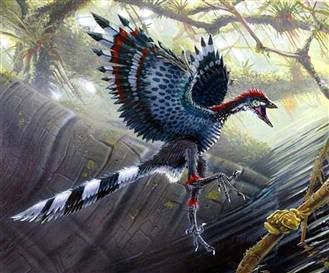
Dinosaur found with birdlike eggs inside Strong support for the dinosaur-to-bird transition came with the discovery of two birdlike eggs inside a fossilized female dinosaur. One of the pineapple-sized, potato-shaped eggs is shown here. The blue color of the shell fragments is added for effect, though the texture is likely realistic, scientists say. The dinosaur, a theropod, could produce two eggs at a time – a capability that lies somewhere between that of primitive reptiles and birds, suggesting a dino-bird linkage. Theropods are considered the closest dinosaur ancestors to modern birds. Reptiles lay a clutch of eggs at once; birds lay one egg at a time. Scientists suspect birds only produce one egg at a time as a means to lighten their load for flight. 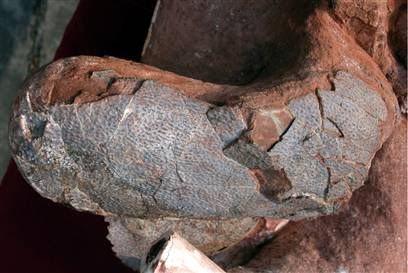
Dino dads guarded eggs, like some birds Male meat-eating dinosaurs such as Troodon, shown in this image, are among the dinosaurs that scientists say guarded nests and brooded developing eggs much the way some birds do today. Daddy day care is the norm among large flightless birds such as emus and rheas, for example. In more than 90 percent of living bird species, males participate in parental care of the young, scientists say. The dino-nest-guarding dads likely freed up moms to forage for meaty meals that allowed them to lay bigger, or more, eggs, which would have increased their chances at reproductive success. It's possible, the researchers add, that the dinosaurs' nests contained eggs from several females, a trait found in ostriches today. 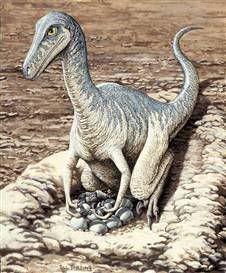
Ancient gunk confirms dino-bird link? Soft tissue found inside a 68-million-year-old Tyrannosaurus rex leg bone dug up in Montana has provided compelling evidence that modern birds are the descendants of dinosaurs. The soft tissue, or gunk, contains collagen proteins. Scientists decoded these proteins and compared them with those of 21 living organisms. They found the dino proteins line up most closely with birds – an ostrich and chicken – than with any other creatures, including alligators and lizards. In this image, Montana State University paleontologist Jack Horner stands with the T. rex leg bone that yielded the telltale gunk. 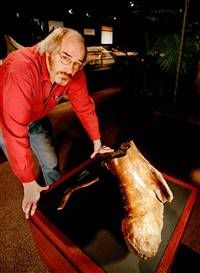
Dinosaurs got small before flight evolved Small size is considered a prerequisite for flight, an adaptation scientists had thought occurred in the earliest bird lineages that eventually took to the skies. But remains of the 2-foot-long dinosaur named Mahakala omnogovae, unearthed in the Gobi Desert and shown here in this artist's reconstruction, suggest that small size was already a common feature among some dinosaurs in the dinosaurian lineages most closely aligned with birds – the dromaeosaurids and troodontids. Small size might have evolved before other flight innovations, scientists say. 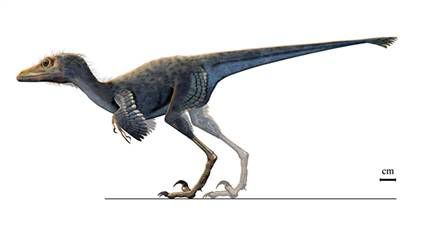
Dinosaur shows how bird breathing evolved An 85-million-year-old carnivorous dinosaur unearthed in Argentina had a breathing system of bellows, or air sacs, which helped pump air through its lungs. Today, only birds breathe in this manner. The bones of the dinosaur, named Aerosteon riocoloradensis, have telltale pockets and a spongelike texture called pneumatization in which air sacs from the lung invade the bone. Though Aerosteon likely had feathers, scientists say it did not fly. Instead, the birdlike breathing system likely evolved to help keep the tipsy two-legged runner more balanced – or perhaps it was a cooling mechanism. In this artistic rendering, the lungs (red) are surrounded by air sacs in other colors. 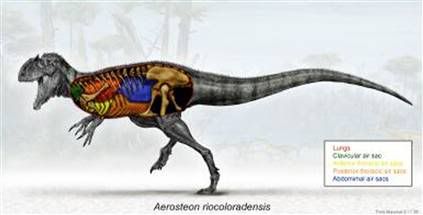
Meat-eating dinos breathed like birds Meat-eating dinosaurs such as the velociraptor shown here had breathing structures called uncinate processes that are also present in birds, researchers have found. The finding adds another layer of evidence linking birds and dinosaurs. Uncinate processes are small bones that act as levers to move the ribs and sternum during breathing, explains Jonathan Codd of the University of Manchester. In a comparison study, he and colleagues found the meat-eating dinosaurs had long uncinate processes similar to those in diving birds such as pelicans and cormorants. 
Birdlike dinosaur had feathers Velociraptor, the fleet-footed dinosaur made famous by Hollywood in the movie Jurassic Park, had feathers, according to a fresh analysis of a forearm unearthed in Mongolia in 1998. The fossil (A in the image above) shows six evenly-spaced quill knobs (B) – bumps where secondary feathers attach to the bone. The same bumps are also shown on a turkey vulture forearm (C). The turkey vulture's feathers (D) and quill knobs (E and F) are also shown. "If animals like velociraptor were alive today, our first impression would be that they were just very unusual-looking birds," said Mark Norell, a curator at the American Museum of Natural History in New York. 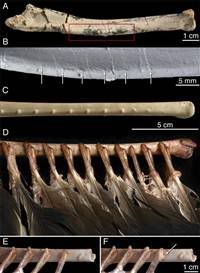
Earliest bird had dino-like feet Archaeopteryx, the earliest known bird, had dinosaur-type feet, according to analysis of the well-preserved fossil shown here. Modern bird feet have a backward-pointing hind toe that helps birds cling to branches and power lines, for example. The Archaeopteryx fossil, however, reveals a first toe extending from the side of its foot, like a human thumb. The configuration is more similar to that of dinosaurs such as velociraptor, which was fast and ran on two feet. The similarity, scientists say, adds to the argument that birds arose from dinosaurs. 
|
|
|
|
|
|
the bottom line is that the flood story is impossible.
|
|
|
|
|
|
Again talk the mighty talk but show me one species that has gone from one species to another separate and complete species....Not going to happen because it just is not so. If we evolved from chimps or apes or whatever they would no longer be here.....Otherwise what would be the purpose of evolving into a sub species....Sorry but just to many holes in this theory folks. It is what it is.....and so take it or leave it.....there is much more evidence of Christ and all that took place in the bible then the precious evolution you hold onto for dear life... And again I ask all that read....1 thing that has evolved just one in the last ok I will give you even 500 years....I have still to wait for this one to be answered... You have evolved from our previous generation. I have evolved, no one stops evolving. Now I know what you mean, all creationist have the same old tired arguments. This dance goes like this. You say , "show me a new species that has evolved". Then you will only accept YOUR own definition of what a species is . . . . I can show MANY MANY new species, its pathetically easy to do, any high school evolution class has many such examples. I have done so on these very forums on different threads. ___________________________________ If you didn't read it before let me say that I will be posting a complete Guide to evolution which will cover this with videos and text analysis in the coming weeks. If you are truly interested in understanding how humans can to be what we are today then you will likely be very interested regardless of your beliefs. you obviously do not understand what evolution is or how it works. It is much easer to just believe something with no evidence then it is to actually pick up a book (other that the bible) and study something. We did not evolve for apes. And no-one that has any understanding of evolution will tell you that. I don't know how I can make that any clearer. And we do have transitional fossels to show an evolutionary process. |
|
|
|
|
|
Apart from the internal problems with the story, there is another kind of evidence that tells us the source of this biblical story of the worldwide deluge. In the middle of the nineteenth century an excavation on the banks of the River Tigris, archaeologists unearthed twelve clay tablets which were written in the then mysterious cuneiform script. Then around the turn of the twentieth century, archaeologists finally managed to decipher the script. They discovered that it was written in Akkadian, the language of ancient royalty and diplomacy. The tablets tell of the story of Gilgamesh.
What interest us here is the story told on the eleventh tablet. In this tablet we are told that Gilgamesh, in his quest for immortality set out on a long journey to look for his ancestor, Utnapishtim. Utnapishtim was already bestowed with eternal life by the gods. Upon reaching the island of Utnapishtim’s abode, Gilgamesh was told a story by his ancestor of a great flood that once swept the world. The similarity between this story and that of Genesis is astounding. The method of destroying all living things of the world was with a great worldwide flood There was a single person singled out by the gods to be saved. This person was commanded to build a massive ark or ship. The ark is to house him, his kinfolk and all kinds of beasts. After the flood receded, the ark came to rest on a mountain. Both arks have windows which were opened after the rain had subsided. A bird was released from the ark once it came to rest on the mountain. The obvious similarities could not have been, not by any stretch of imagination, due to coincidence. One of the account is clearly dependent on the other. So the question is, which is the original and which is the copy? There are many reasons to believe that the Babylonian version is the original: The first is antiquity. The writing of the epic of Gilgamesh has been dated by archaeologists to around 2000 BCE. Thus it predates the Genesis account by at least a few centuries. The second is the presence of loan words. The Akkadian word for pitch (or bitumen): kofer. This is precisely the word used in the Genesis story. Nowhere else in the Bible does the word kofer appears except in the story of the flood. [4] The third is the general flow of influence. We would expect the greater civilization to have a greater cultural influence on a lesser one. Compared to Babylonia, Israel was, as Cyrus Gordon said, a "backwater of sorts". The fourth reason is from the original source of the myth. Floods are common in the Mesopotamian plains, it is unusual in usually arid Israel. It is easy to see how the flood myth could have originated from some stories told in the Babylonian plains, it is not so easy to see how anyone from Israel could have thought of that myth originally. Finally, the location of the story gives a clue to its origins. The geography of the ark story points towards its Mesopotamian origin. Noah’s ark landed on Mount Ararat, which is at the headwaters of the Tigris and Euphrates. It is therefore conclusive that the story in Genesis is a direct descendent of the Babylonian story. The Akkadian tablets, like the story in Genesis, are collections of myths. There was, however, a brief period of respectability, in the first half of the twentieth century, given to the notion of the occurrence of an actual catastrophic flood. An archaeological expedition in 1929 led by Sir Charles Leonard Wooley (1880-1960) found at the site of the ancient city of Ur, a stratum of clean clay about eight feet thick. Wooley originally estimated the layer of silt to be about four hundred miles long and about one hundred miles wide. The layer was dated at around 4000BC. Had this been true, a flood of such a magnitude would certainly has qualified as "world-wide" to the ancient Babylonians, for the area estimated by Wooley represented the whole of the known world to them. However, subsequent expeditions has shown that the thick layer of silt is localized and was nowhere as widespread as Wooley first thought it to be. Was Noah actually a historical person? Again archaeological evidence supplied the answer. In 1933 clay tablets were discovered in Mari, an ancient city in the Mesopotamian plain. In these tablets (there were about 20,000 discovered), the name Noah appeared many times; as the name of a god. In fact Noah’s name is actually a musculanisation of the goddess of rain, Nuah. Notes a. The story of the twelve tablets were estimated to have been written about 2000 BCE. Even assuming "best case" biblical chronology, i.e. that Genesis was written by Moses himself, this brings the writing of Genesis to only about 1400 BCE. Thus the Akkadian tablet is earlier than the Genesis story. According to critical theologians, the earliest form of the Hebrew flood story was written only around 900 BCE. But the version as we have it in the Bible was not complete until the period of the exile c. 6th century BCE. b. The flood story is a myth, of course, as we have shown earlier. |
|
|
|
|
|
There is no essential conflict between the bible and evolution unless you take the bible literally which results in well just a whole lotta problems. actually the bible is not compatible with evolution unless you throw aout the adam and eve story the flood story the ages of the people in the bible and a whole lot of other stuff. So you either believe in this fairy tale or you believe in facts and science you can not have both. Evolution is not proof of no god but it is proof that the bible is false. |
|
|
|
|
|
I will not quote the cut and paste here but historical validity of the bible is questionable at best. Just like old folk stories, which the bible actually is, there is always a remnant of some place or event that may have actually happened in the story line but it does not make the folk tale historically valid at any point. Faith is just that believing blindly in something someone told you is truth without any proof of any kind. Science is the process of verifying facts to correspond with other facts and then draw a conclusion. No similarity there at all other than they both will be written by man How is the historical validity of the bible questionable? What folklore are you referring to? Biblical faith is not meant to be a vacuous leap as it were. Oh but it is a large leap of faith if you do not believe that the bible is true, right? Just like all scientific theories, it has to be true on more than one plane of facts in order to be considered a fact or true so where else does the bible ring true? Is Jesus part of history in any other town histories? How about birth records and such? Are any of these so called prophets documented anywhere? If not then they are part of folk lore. Folk lore like I said before usually has a smidgeon of something real in it be it a real location or maybe a real person but the rest of the story is someone's imagination, in the case of the bible it is many people's imagination, the original writers of the individual stories, the people who edited these stories to fit what they wanted them to say and the people in power who chose what actually made it into the bible and what was not of the "right" mindset to be included. If you take the TAUGHT reverence out of your thought process and read the bible as a story book, like it should have been done, then you can see the parables and lessons of the writers but you can also see the lack of fact. This comes from a debate btw. William Land Craig and Bart Erhman. Craig argues for the affirmative position. Take the time to read. This is why I treat the ressurection as highly probable. Fact #1: After his crucifixion Jesus was buried by Joseph of Arimathea in a tomb. Historians have established this fact on the basis of evidence such as the following: 1. Jesus’ burial is multiply attested in early, independent sources. We have four biographies of Jesus, by Matthew, Mark, Luke, and John, which have been collected into the New Testament, along with various letters of the apostle Paul. Now the burial account is part of Mark’s source material for the story of Jesus’ suffering and death. This is a very early source which is probably based on eyewitness testimony and which the commentator Rudolf Pesch dates to within seven years of the crucifixion. Moreover, Paul also cites an extremely early source for Jesus’ burial which most scholars date to within five years of Jesus’ crucifixion. Independent testimony to Jesus’ burial by Joseph is also found in the sources behind Matthew and Luke and the Gospel of John, not to mention the extra-biblical Gospel of Peter. Thus, we have the remarkable number of at least five independent sources for Jesus’ burial, some of which are extraordinarily early. 2. As a member of the Jewish Sanhedrin that condemned Jesus, Joseph of Arimathea is unlikely to be a Christian invention. There was an understandable hostility in the early church toward the Jewish leaders. In Christian eyes, they had engineered a judicial murder of Jesus. Thus, according to the late New Testament scholar Raymond Brown, Jesus’ burial by Joseph is “very probable,” since it is “almost inexplicable” why Christians would make up a story about a Jewish Sanhedrist who does what is right by Jesus. For these and other reasons, most New Testament critics concur that Jesus was buried by Joseph of Arimathea in a tomb. According to the late John A. T. Robinson of Cambridge University, the burial of Jesus in the tomb is “one of the earliest and best-attested facts about Jesus.” Fact #2: On the Sunday after the crucifixion, Jesus’ tomb was found empty by a group of his women followers. Among the reasons which have led most scholars to this conclusion are the following: 1. The empty tomb is also multiply attested by independent, early sources. Mark’s source didn’t end with the burial, but with the story of the empty tomb, which is tied to the burial story verbally and grammatically. Moreover, Matthew and John have independent sources about the empty tomb; it’s also mentioned in the sermons in the Acts of the Apostles (2.29; 13.36); and it’s implied by Paul in his first letter to the Corinthian church (I Cor. 15.4). Thus, we have again multiple, early, independent attestation of the fact of the empty tomb. 2. The tomb was discovered empty by women. In patriarchal Jewish society the testimony of women was not highly regarded. In fact, the Jewish historian Josephus says that women weren’t even permitted to serve as witnesses in a Jewish court of law. Now in light of this fact, how remarkable it is that it is women who are the discoverers of Jesus’ empty tomb. Any later legendary account would certainly have made male disciples like Peter and John discover the empty tomb. The fact that it is women, rather than men, who are the discoverers of the empty tomb is best explained by the fact that they were the chief witnesses to the fact of the empty tomb, and the Gospel writers faithfully record what, for them, was an awkward and embarrassing fact. I could go on, but I think enough has been said to indicate why, in the words of Jacob Kremer, an Austrian specialist on the resurrection, “By far most exegetes hold firmly to the reliability of the biblical statements concerning the empty tomb.” Fact #3: On different occasions and under various circumstances different individuals and groups of people experienced appearances of Jesus alive from the dead. This is a fact which is virtually universally acknowledged by scholars, for the following reasons: 1. Paul’s list of eyewitnesses to Jesus’ resurrection appearances guarantees that such appearances occurred. Paul tells us that Jesus appeared to his chief disciple Peter, then to the inner circle of disciples known as the Twelve; then he appeared to a group of 500 disciples at once, then to his younger brother James, who up to that time was apparently not a believer, then to all the apostles. Finally, Paul adds, “he appeared also to me,” at the time when Paul was still a persecutor of the early Jesus movement (I Cor. 15.5-8). Given the early date of Paul’s information as well as his personal acquaintance with the people involved, these appearances cannot be dismissed as mere legends. 2. The appearance narratives in the Gospels provide multiple, independent attestation of the appearances. For example, the appearance to Peter is attested by Luke and Paul; the appearance to the Twelve is attested by Luke, John, and Paul; and the appearance to the women is attested by Matthew and John. The appearance narratives span such a breadth of independent sources that it cannot be reasonably denied that the earliest disciples did have such experiences. Thus, even the skeptical German New Testament critic Gerd Lüdemann concludes, “It may be taken as historically certain that Peter and the disciples had experiences after Jesus’ death in which Jesus appeared to them as the risen Christ.” Fact #4: The original disciples suddenly and sincerely came to believe that Jesus was risen from the dead despite their having every predisposition to the contrary. Think of the situation the disciples faced following Jesus’ crucifixion: 1. Their leader was dead. And Jewish Messianic expectations had no idea of a Messiah who, instead of triumphing over Israel’s enemies, would be shamefully executed by them as a criminal. 2. Jewish beliefs about the afterlife precluded anyone’s rising from the dead to glory and immortality before the general resurrection of the dead at the end of the world. Nevertheless, the original disciples suddenly came to believe so strongly that God had raised Jesus from the dead that they were willing to die for the truth of that belief. But then the obvious question arises: What in the world caused them to believe such an un-Jewish and outlandish thing? Luke Johnson, a New Testament scholar at Emory University, muses, “Some sort of powerful, transformative experience is required to generate the sort of movement earliest Christianity was.”5 And N. T. Wright, an eminent British scholar, concludes, “That is why, as an historian, I cannot explain the rise of early Christianity unless Jesus rose again, leaving an empty tomb behind him." (II) The best explanation of these facts is that Jesus rose from the dead. This, of course, was the explanation that the eyewitnesses themselves gave, and I can think of no better explanation. The Resurrection Hypothesis passes all of the standard criteria for being the best explanation, such as explanatory power, explanatory scope, plausibility, and so forth. Of course, down through history various alternative naturalistic explanations of the resurrection have been proposed, such as the Conspiracy Hypothesis, the Apparent Death Hypothesis, the Hallucination Hypothesis, and so on. In the judgment of contemporary scholarship, however, none of these naturalistic hypotheses has managed to provide a plausible explanation of the facts. Nor does Dr. Ehrman support any of these naturalistic explanations of the facts. So why, we may ask, does Dr. Ehrman not accept the resurrection as the best explanation? The answer is simple: the resurrection is a miracle, and Dr. Ehrman denies the possibility of establishing a miracle. He writes, “Because historians can only establish what probably happened, and a miracle of this nature is highly improbable, the historian cannot say it probably occurred.”9 This argument against the identification of a miracle is an old one, already refuted in the 18th century by such eminent scholars as William Paley and George Campbell, and is rejected as fallacious by most contemporary philosophers as well. Now I’ve promised to say more about this later; but for now, let me simply say that in the absence of some naturalistic explanation of the facts, Dr. Ehrman’s hesitancy about embracing the resurrection of Jesus as the best explanation is really quite unnecessary. Dr. Ehrman would be quite within his rational rights to embrace a miraculous explanation like the resurrection—and so would we. that is so far from any kind of fact it's crazy. These are NOT facts, period. There are 0 facts to support a resurrection. in fact the eveidence shows it not happening. The first recorded appearance story (in terms of when it was written, not when it was supposed to have happened) is of the appearance to Paul, and it is clearly a vision. In one account, he does not see Jesus, only a flash of light (9.3-5), and those with him do not see Jesus, but only hear him (Acts 9.7). Paul could have been speaking in another voice, which the others took as Jesus (or which the author of Acts portrays them as taking to be Jesus, since we don't have their account of it, after all). But the fact that no one, not even Paul, saw Jesus in the flesh makes the point well enough. Most importantly, Paul never says in his letters that he ever saw Jesus in the flesh (he even denies it in Galatians 1). Moreover, this particular encounter in Acts has all the earmarks of something like a seizure-induced hallucination: Paul alone sees a flash of light, collapses, hears voices, and goes blind for a short period. An embolism is sufficient to cause or explain all of this. We can add to this the fact that the earliest manuscripts of the earliest gospel, Mark, do not describe any appearances of Jesus. Paul gives other accounts of his vision which claim that others saw it, too. Doesn't this suggest a genuine vision from God? First of all, there is still never any mention of Jesus appearing in the flesh. Rather, all that appears is a light from heaven (phôs ek tou ouranou, 9.3; ek tou ouranou...phôs, 22.6; ouranothen...phôs, 26.13). So even if several saw the light, it can still have a natural explanation, from lightning to a reflection from a distant object, or even a simple ray of sunlight peaking through a cloud, any of which could also have induced a seizure or affected Paul emotionally, causing an hallucination (or inspiration). And since we don't have the story from any of these other observers, the story could be embellished or fabricated at leisure, for whatever reason. In my opinion, Paul may have seen in Christianity a way to save the Jews from destruction at the hands of the Romans by displacing their messianic motives to rebel, and creating a new Judaism more agreeable to the Gentiles, open to all and thus uniting rather than dividing, and more submissive to outside authority by internalizing and spiritualizing religious faith, eliminating messianic (and violent) emphasis on the Temple, and postponing material and social complaints by referring them to an afterlife. This could have been a deliberate or a subconscious motivator for Paul and others leading the movement. In Paul's case, guilt at what he had done to good people, and admiration for their moral program and fortitude, may have also played an emotional role. |
|
|
|
|
|
Topic:
rush limbaugh
|
|
|
probably not, broadcast companies routinely keep shows on the air for 20+ years when noone listens... he's up to 22 million listeners a week... according to him. He's looseing listeners, and he knows it that why he's reverting back to his old dj days. |
|
|
|
|
|
Limbaugh?

He's just some washed up dj that found a nitch. He is as credible as Howard Stern. |
|
|
|
|






